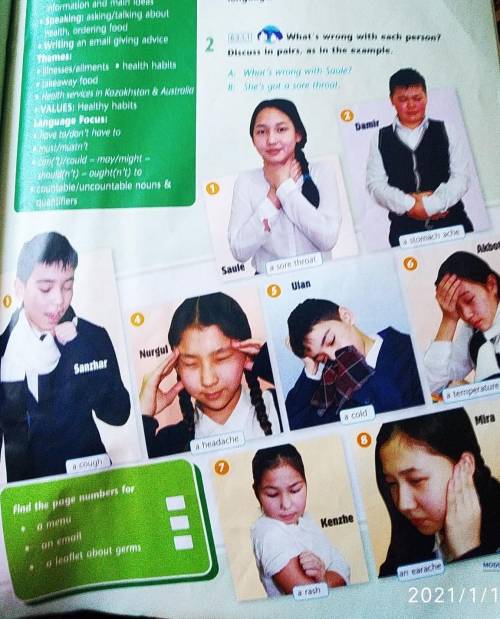Ex 2p53 SB
What`s wrong with Saule?
She`s got a sore throat.

Другие вопросы по теме Английский язык
Популярные вопросы
- Почему 19 век век капитала?...
3 - Внесок українських вчених у розвиток біології...
3 - решение задачи вертолёт за 4часа может пролететь 720км. какое расстояние...
3 - Розв язати систему лінійних рівнянь додавання...
3 - Визначити до якої частини мови належить кожне слово в реченні. 1. На вулиці...
2 - на кінець року населення міста становило 72100мешканців Визначте кількість...
1 - 3 Complete the sentences with the correct form of the adjectives and adverbs....
3 - Вычисли. 85 800 - 5000 -800 136 876 -30 000 -70 450 000 +800 +7000 35 400...
3 - Составить предложения со словами: шамалышақтықаралытамантартажуықжақын...
1 - Висловлювання щодо роль книги в епоху сучасних технологій...
3
To provide a detailed and comprehensive answer with justification and step-by-step explanation, we can break it down as follows:
1. Understanding the question: The question is asking about Saule's problem or condition.
2. Explaining the problem: Saule is suffering from a sore throat. This means that her throat is painful and inflamed, which could make it difficult or uncomfortable for her to swallow, speak, or breathe.
3. Identifying the cause: There could be various reasons for a sore throat, such as a viral or bacterial infection, allergies, or excessive strain on the throat muscles.
4. Justification for the answer: The answer "She's got a sore throat" is based on the information given in the exercise or previous context. It is important to refer to the relevant text or context to ensure accuracy.
5. Providing an image: The image included is meant to depict or represent the concept of a sore throat visually. It can help students make a connection between the written information and visual representation, enhancing their understanding of the topic.
By following these steps, we can explain the answer clearly and comprehensively to a student, ensuring they understand the question, the problem, its causes, and the given answer.